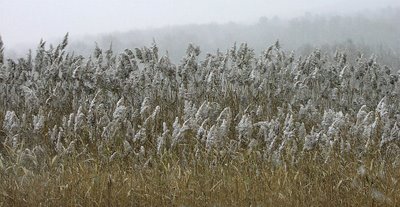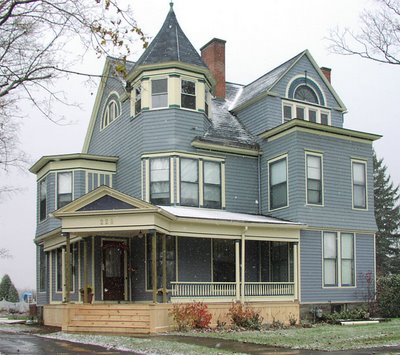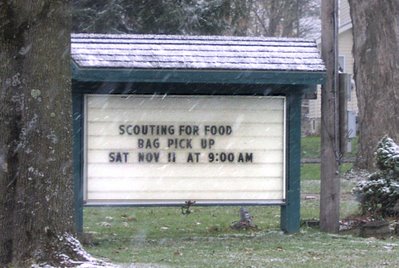Lincoln-Davies and Morgan's Hardware have each probably sold a few snow shovels this morning! It has snowed off and on for several hours, but with very little accumulation to show for it. Trees and shrubs had the greatest amount of "frosting," especially the "Ditch Weed" along Route 12 South of Sangerfield.
Phragmites communis.
A tall North American reed having relative wide leaves and large plumelike panicles; widely distributed in moist areas and generally considered a nuisance! It does have its uses, however, which include: high quality warm-season forage and is readily eaten by cattle and horses. However, it becomes tough and unpalatable after maturity. Animals grazing this grass during winter should be fed a protein concentrate.
- Extensively used in Mediterranean region and elsewhere for building dwellings, lattices, fences, arrows by Indians, and for weaving mats and carrying nets.
- Young shoots sometimes used as a vegetable.
- The stalks exude a manna-like gum which is eaten. The rhizomes and roots also serve as emergency food.
- In Russia they are harvested and processed into starch.
- The reed is useful in the manufacture of pulps for rayon and paper.
- Pens for writing on parchment were cut and fashioned from this reed, and the
- stems were used as a linear measuring device.
- It can be processed into a fine fibrous material suitable as a filler in upholstery.
- Flowering stalks yield a fiber suitable for rope making.
- It is also used for thatching and for making partitions, fences, coarse mats, baskets, sandals, etc.
- Thin stems are made into pens; panicles are used for making brooms and for decoration.
According to Hartwell (1967–1971), the plant is used in folk remedies for condylomata, indurated breast, mammary carcinomata, and leukemia. Reported to be alexeteric, diaphoretic, diuretic, emetic, refrigerant, sialogogue, stomachic, and sudorific, the common reed is a folk remedy for abscesses, arthritis, bronchitis, cancer, cholera, cough, diabetes, dropsy, dysuria, fever, flux, gout, hematuria, hemorrhage, hiccup, jaundice, leukemia, lung, nausea, rheumatism, sores, stomach, thirst, and typhoid.
AND, finally ...... the Swiss use it in making bagpipes!
(There's such a great quantity of ditch weed right at hand that it's a shame we can't figure out some entirely new use for phragmites. For instance: no one mentions anything about being able to distill any part of the plant: are we missing an important opportunity for advancement, here?)


Carpentry projects at the Hotel and at the Petrie residence on White Street
are finishing up just in time!
are finishing up just in time!
And - in case it was snowing so hard that you couldn't see the Bulletin Board in the Park, here's a closer look. (Click to enlarge photographs.)

Looking back to July, just about four months ago! Alot has happened these last two years!


(I knew someone would ask!)
The first resident at "Hubbard's Corners" was Captain Simon Hubbard. He must have settled there in 1790 or 91 for it was at his house that, according to Pomroy Jones' 1851 "Annals of Oneida County, History of the Town of Sangerfield," "About the first of March, 1792, Minierva Hale and wife, and Nathan Gurney and wife and infant, moved into the town from New Hartford, where they had previously resided one or two years. The first day of their journey they reached the house of Simon Hubbard, who lived on the place now (1851) occupied by his son Marinus Hubbard, in the town of Marshall, where they remained over night."
Perhaps it wasn't a "corners," or junction, back than, but whenever Summit Road came in to use, probably as a primary road to and from the Sauquoit Valley, the term "Hubbard's Corners" made sense.
Miscellaneous bits from this week's "Social Notes and Items of Interest..."
Katie Peck has seen all-black caterpillars and old-timers say that there’s so much moisture in the soil we’re bound to have a lot of snow this Winter!
Folks in East Main Street wonder if the railings that are supposed to be installed next to the three new sets of stairs leading from the street to the sidewalk will be in place before slippery weather gets here.
The WCS Boys Varsity Soccer Team may have brought a somewhat passé haircut back into fashion: “the Mohawk” is now “in!” (Doubly “cool!”)
According to her daughter, Ms. LeeAnn Miller, Mrs. Shirley Spearing is making an excellent recovery from hip-replacement surgery and is currently in “rehab” at Hamilton.
The Keating Family, who usually tell us about their Summertime camping trips, only made two warm-weather ventures to the North Country and were met, each time, with rain. They are, however, having an enjoyable Autumn receiving frequent news from Ms. Chelsea Keating, who is studying in England!
Although we have not had a formal “report,” we believe that the ladies of the Crimson Bonnets were to have their monthly gathering - last Thursday - at the “Red Lobster.”
Members of the Waterville Garden Club will meet today (Wednesday, November 1st) at the home of the new club president, Bonnie Dobmeier, on Frog Park Road.
Bright posters are up advertising the St. Bernard’s annual Bazaar and Luncheon on Saturday, November 11th. Bazaar hours are 9:00 A.M. ‘til 3:00 P.M. and Lunch will be served from 11:30 until 2:00. We’ll be there!
And we’ll also be ready when The Waterville Women’s Club will hold one of their famous Bake Sales at Foodking on November 18th! (Perfect timing: stock the freezer with goodies for the holidays!) On the 21st, they’ll have “Harvest Tea” at “Hannah Leigh Antiques” and then reassemble at Village Hall at 7:00 in the evening for antiques appraisals. (Details will be forthcoming.)
No: that’s not a new furniture store on Main Street! Tommy Morgan has made arrangements to use the future “Subway” as an additional showroom, for the time-being. (I've tried to determine exactly what the status of "Subway" is, but get a frustratingly indefinite "On Hold, for now.")